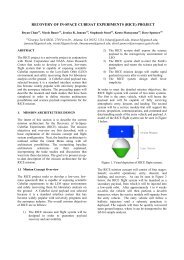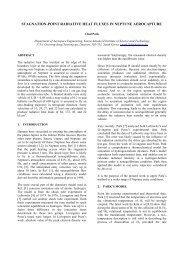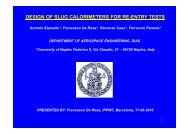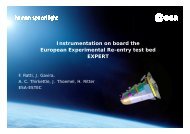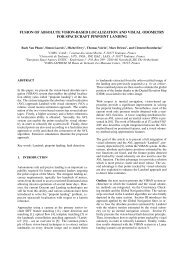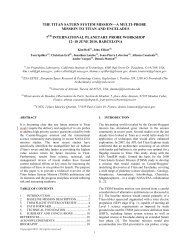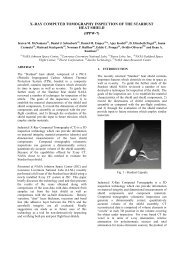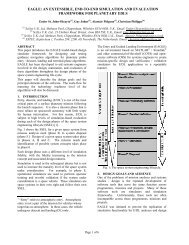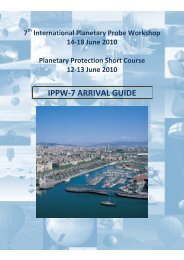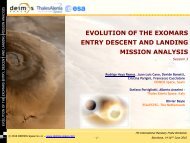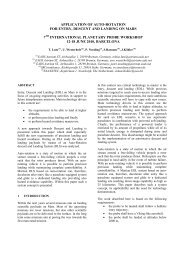efficient data compression for spacecraft ... - SpaceWire - ESA
efficient data compression for spacecraft ... - SpaceWire - ESA
efficient data compression for spacecraft ... - SpaceWire - ESA
You also want an ePaper? Increase the reach of your titles
YUMPU automatically turns print PDFs into web optimized ePapers that Google loves.
EFFICIENT DATA COMPRESSION FOR SPACECRAFT<br />
INCLUDING PLANETARY PROBES<br />
M. Cabral (1) , R. Trautner (1) , R. Vitulli (1) , C. Monteleone (2)<br />
(1) TEC-EDP, <strong>ESA</strong>/ESTEC, Noordwijk, The Netherlands<br />
(2) TEC-EDD, <strong>ESA</strong>/ESTEC, Noordwijk, The Netherlands<br />
Email: Roland.Trautner@esa.int<br />
ABSTRACT<br />
For all types of space missions, the available<br />
bandwidth <strong>for</strong> the transmission of <strong>data</strong> back to Earth is<br />
an important constraint with significant impact on<br />
vehicle design, onboard resources, and mission<br />
operations. The <strong>efficient</strong> <strong>compression</strong> of science and<br />
housekeeping <strong>data</strong> allows maximizing the utilization of<br />
available bandwidth and onboard resources.<br />
While <strong>data</strong> <strong>compression</strong> is traditionally used <strong>for</strong><br />
science payload <strong>data</strong>, the <strong>compression</strong> of <strong>spacecraft</strong><br />
housekeeping <strong>data</strong> is becoming increasingly attractive<br />
in particular <strong>for</strong> exploration and science missions that<br />
have significant bandwidth constraints.<br />
We present a summary of present and upcoming<br />
standardized <strong>data</strong> <strong>compression</strong> algorithms <strong>for</strong> on-board<br />
implementation, including <strong>ESA</strong>'s latest related<br />
developments such as a new implementation of the<br />
CCSDS-122.0 (image <strong>data</strong> <strong>compression</strong>) standard,<br />
per<strong>for</strong>mant multispectral <strong>data</strong> <strong>compression</strong> algorithms,<br />
and research on simple pre-processing steps which<br />
improve the <strong>compression</strong> per<strong>for</strong>mance in particular <strong>for</strong><br />
packetized <strong>data</strong> such as <strong>spacecraft</strong> housekeeping <strong>data</strong>.<br />
Test results <strong>for</strong> various <strong>compression</strong> algorithms are<br />
presented, and a new software tool is introduced which<br />
supports the evaluation of standardized <strong>data</strong><br />
<strong>compression</strong> algorithms by industry and by payload<br />
teams.<br />
1. INTRODUCTION<br />
The reduction of redundancy / in<strong>for</strong>mation content in<br />
<strong>data</strong> by means of <strong>data</strong> <strong>compression</strong> is an important<br />
technology, with widespread use in many application<br />
fields. Space missions were among the early adopters<br />
of <strong>data</strong> <strong>compression</strong>, with applications already<br />
implemented in the days of the Apollo program [1].<br />
Due to the associated reduction of on-board <strong>data</strong><br />
storage capacity and downlink bandwidth requirements,<br />
<strong>data</strong> <strong>compression</strong> is traditionally used in particular <strong>for</strong><br />
science payload <strong>data</strong>. Recent European space missions<br />
like Huygens [2], Mars Express [3], or Venus Express<br />
[4] have implemented <strong>data</strong> <strong>compression</strong> <strong>for</strong> high<br />
bandwidth type instruments such as cameras and<br />
spectrometers. However, none of these missions used<br />
<strong>compression</strong> <strong>for</strong> instrument and <strong>spacecraft</strong> housekeeping<br />
<strong>data</strong> mainly due to conservatism in<br />
engineering approaches. This area is addressed by<br />
recent work [5] and it is expected that <strong>compression</strong> <strong>for</strong><br />
plat<strong>for</strong>m <strong>data</strong> will be more common in the future.<br />
Data <strong>compression</strong> can be implemented in hardware or<br />
software. The decision on the implementation plat<strong>for</strong>m,<br />
and the selection of a suitable algorithm, is based on a<br />
tradeoff of a number of factors, such as:<br />
• Compression per<strong>for</strong>mance<br />
• Lossy versus lossless <strong>compression</strong><br />
• Associated hardware requirements<br />
• Associated software requirements<br />
• Impact on system complexity<br />
• Impact on reliability, including <strong>data</strong> integrity<br />
• Compatibility with TM and ground systems<br />
• Implementation cost<br />
In order to minimize the added complexity needed <strong>for</strong><br />
the implementation, algorithms are required that<br />
provide high <strong>compression</strong> per<strong>for</strong>mance with minimum<br />
consumption of on-board resources. All compressed<br />
<strong>data</strong> needs to be as robust as possible <strong>for</strong> minimizing<br />
the propagation of errors in the <strong>data</strong>. The impact on<br />
cost, reliability and system compatibility can be<br />
significantly reduced by standardization and re-use of<br />
<strong>efficient</strong> algorithms.<br />
<strong>ESA</strong> has, in cooperation with major space agencies,<br />
supported the development and standardization of<br />
<strong>efficient</strong> <strong>data</strong> <strong>compression</strong> algorithms that provide high<br />
per<strong>for</strong>mance as well as low resource requirements. The<br />
standardization of algorithms supports the public<br />
availability of high quality documentation and the<br />
establishment of a broad user community. Algorithm<br />
specifications, test <strong>data</strong>, implementation guidelines and<br />
some software code are available via the services<br />
provided by CCSDS [6] and its members including<br />
<strong>ESA</strong> [7].
In the following chapters, <strong>data</strong> <strong>compression</strong> test<br />
hardware and test <strong>data</strong> sets are described. CCSDS<br />
standardized <strong>data</strong> <strong>compression</strong> algorithms and a<br />
standardization candidate <strong>for</strong> hyper/multispectral <strong>data</strong><br />
<strong>compression</strong> are briefly introduced, and <strong>ESA</strong><br />
implementations of the algorithms are presented,<br />
together with per<strong>for</strong>mance test results on a state of the<br />
art space qualified CPU [8]. The <strong>compression</strong><br />
per<strong>for</strong>mance, memory requirements, processing<br />
efficiency, and error resilience are addressed. Based on<br />
test results, recommendations on the utilization of the<br />
individual algorithms are made.<br />
A selection of simple pre-processing steps <strong>for</strong> packet<br />
telemetry <strong>data</strong> is introduced which allows achieving<br />
significant per<strong>for</strong>mance gains in combination with<br />
standardized <strong>compression</strong> algorithms. Test results <strong>for</strong><br />
typical <strong>data</strong> sets are presented.<br />
Finally, a new <strong>ESA</strong> software tool <strong>for</strong> the evaluation of<br />
standardized <strong>data</strong> <strong>compression</strong> algorithms by industry<br />
and by payload teams is introduced.<br />
2. DATA COMPRESSION TEST HARDWARE<br />
AND DATA<br />
The efficiency tests of the CCSDS 121.0 and 122.0<br />
implementations were per<strong>for</strong>med using a development<br />
board based on a <strong>SpaceWire</strong> Remote Terminal<br />
Controller (SpW-RTC) [8], [9]. This device includes an<br />
embedded LEON2 microprocessor, and a range of<br />
standard interfaces and resources (UARTs, timers,<br />
general purpose input output). The key specifications<br />
can be summarized as follows:<br />
• RTC ASIC with a 50 MHz core clock speed<br />
• 34 Dhrystone MIPS<br />
• 16 Mbyte RAM, 16 Mbyte PROM, EEPROM<br />
• SpW, CAN bus and serial interfaces<br />
This computer board is representative to many<br />
contemporary on-board computers in terms of CPU<br />
architecture and per<strong>for</strong>mance.<br />
Two types of images were used on these tests: images<br />
from the CCSDS image library [10] and completely<br />
black and random images, which provide a best and<br />
worst case <strong>for</strong> compressibility.<br />
Four versions of black and random images were used,<br />
with different dimension and representation:<br />
• 512x512x8 (512 by 512 pixels and 8 bits per pixel)<br />
• 512x512x12<br />
• 1024x1024x8<br />
• 1024x1024x12<br />
The four images selected from the CCSDS library have<br />
dimensions identical to the black and random images.<br />
Their filenames in the CCSDS test <strong>data</strong>set are<br />
marstest.raw, sun_spot.raw, b1.raw and solar.raw.<br />
3. CCSDS 121.0 – GENERAL PURPOSE<br />
LOSSLESS DATA COMPRESSION<br />
The CCSDS 121.0 [11] standard is based on Rice<br />
coding, which was developed by Robert F. Rice at<br />
NASA. A lossless source coding technique preserves<br />
source <strong>data</strong> accuracy and removes redundancy in the<br />
<strong>data</strong> source. In the decoding process, the original <strong>data</strong><br />
can be reconstructed from the compressed <strong>data</strong> by<br />
restoring the removed redundancy; the de<strong>compression</strong><br />
process adds no distortion. This technique is<br />
particularly useful when <strong>data</strong> integrity cannot be<br />
compromised. The drawback is generally a lower<br />
<strong>compression</strong> ratio, which is defined as the ratio of the<br />
number of original uncompressed bits to the number of<br />
compressed bits including overhead bits necessary <strong>for</strong><br />
signalling parameters.<br />
The lossless Rice coder consists of two separate<br />
functional parts: the preprocessor and the adaptive<br />
entropy coder. Two of the factors contributing to the<br />
per<strong>for</strong>mance measure in the coding bit rate<br />
(bits/sample) of a lossless <strong>data</strong> <strong>compression</strong> technique<br />
are the amount of correlation removed among <strong>data</strong><br />
samples in the preprocessing stage, and the coding<br />
efficiency of the entropy coder. The function of the<br />
preprocessor is to de-correlate <strong>data</strong> and re<strong>for</strong>mat them<br />
into non-negative integers with the preferred<br />
probability distribution. The Adaptive Entropy Coder<br />
(AEC) includes a code selection function, which<br />
selects the coding option that per<strong>for</strong>ms best on the<br />
current block of samples. The selection is made on the<br />
basis of the number of bits that the selected option will<br />
use to code the current block of samples. An ID bit<br />
sequence specifies which option was used to encode<br />
the accompanying set of codewords.<br />
Tables 1 and 2 show the per<strong>for</strong>mance of the CCSDS<br />
121.0 lossless <strong>compression</strong> algorithm. They contain,<br />
respectively, the <strong>compression</strong> ratio and the execution<br />
time measured on the SpW-RTC. The tests were<br />
per<strong>for</strong>med on the selected images available from [10].<br />
Table 1. Compression ratios <strong>for</strong> test images using CCSDS<br />
121.0 on the SpW-RTC<br />
File ([width]x[height]x[bit depth])<br />
Ratio<br />
marstest.raw (512x512x8) 1,51<br />
sun_spot.raw (512x512x12) 1,76<br />
b1.raw (1024x1024x8) 2,18<br />
solar.raw (1024x1024x12) 1,64
Table 2. Compression times <strong>for</strong> test images using CCSDS<br />
121.0 on the SpW-RTC (ms)<br />
Black Image Random<br />
512x512x8 619 1844 2202<br />
512x512x12 637 2664 3540<br />
1024x1024x8 2478 6454 8808<br />
1024x1024x12 2548 10919 14160<br />
It can be seen that black and random images provide a<br />
best and worst-case <strong>for</strong> execution time, with the real<br />
images having an intermediate value.<br />
4. CCSDS 122.0 – IMAGE DATA<br />
COMPRESSION<br />
The Image Data Compression (IDC) recommendation<br />
[12] has been designed <strong>for</strong> use in rockets, satellites, or<br />
<strong>spacecraft</strong>. It is expected that the technique is<br />
applicable to many types of instruments in such<br />
equipment. There<strong>for</strong>e this coding system design is<br />
designed to satisfy all the memory and computation<br />
restrictions of this kind of equipment.<br />
The IDC standard is designed <strong>for</strong> both lossless and<br />
lossy <strong>compression</strong>. When using lossless <strong>compression</strong>,<br />
the original image can be recovered exactly, while if<br />
lossy <strong>compression</strong> is used, approximations in different<br />
stages produce some loss of in<strong>for</strong>mation that cannot be<br />
recovered even by transmitting the complete bit stream.<br />
The IDC technique is designed <strong>for</strong> monoband<br />
<strong>compression</strong>. The encoding process is divided in two<br />
functional parts. First, a Discrete Wavelet Trans<strong>for</strong>m<br />
(DWT) is per<strong>for</strong>med in order to decorrelate the original<br />
<strong>data</strong>. Then, the trans<strong>for</strong>med <strong>data</strong> are rearranged in 8×8<br />
blocks. Blocks are grouped in segments. The number<br />
of blocks in a segment depends on the available<br />
memory to store the segment. Finally, each segment is<br />
independently encoded by the Bit Plane Encoder (BPE).<br />
Each 16 consecutive blocks within a segment are<br />
grouped con<strong>for</strong>ming a gaggle. Blocks in a gaggle are<br />
entropy coded together. The number of blocks in a<br />
segment is usually selected using two criteria: the strip<br />
and the frame modes. The strip mode consists of<br />
selecting the number of blocks in a segment as the<br />
available blocks in a row. The frame mode consists of<br />
encoding all the blocks of the image in one single<br />
segment.<br />
4.1 <strong>ESA</strong>'s new algorithm implementation<br />
Several implementations of the CCSDS 122.0 standard<br />
are already available [13]. However, among other<br />
problems, they typically require a lot of memory (at<br />
least 4 bytes <strong>for</strong> each pixel on the original image), can<br />
only read the input image from a file and output the<br />
compressed <strong>data</strong> to another file. These design features<br />
are not problematic when the software code is executed<br />
on a workstation, but they make it hard to port the<br />
application to a space plat<strong>for</strong>m.<br />
There<strong>for</strong>e, <strong>ESA</strong> has developed a new implementation<br />
of the standard. It is written in C and supports all the<br />
options defined in the CCSDS 122.0 standard. It uses<br />
less memory than previous implementations, and<br />
allows different input and output options such as files,<br />
memory, or network interfaces.<br />
Memory usage<br />
<strong>ESA</strong>'s implementation uses a memory-<strong>efficient</strong> DWT<br />
calculation scheme, which significantly reduces the<br />
algorithm’s memory requirements. We have<br />
characterized the memory usage of the implementation,<br />
and verified it using the Massif memory profiler. The<br />
required memory is divided into four main components:<br />
1. Discrete Wavelet Trans<strong>for</strong>m (DWT) buffers<br />
2. Buffer to store the trans<strong>for</strong>med coefficents<br />
3. Bit Plane Encoder (BPE) buffers<br />
4. Other memory <strong>for</strong> variables and temporary buffers<br />
Fig. 1. IDC encoding process<br />
The total memory usage M of the implementation can<br />
be calculated as<br />
355* S<br />
M 207*<br />
w 429bytes<br />
(1)<br />
2<br />
where S is the segment size parameter and w is the<br />
image width in pixels, including padding (the CCSDS<br />
122.0 standard requires images to be padded so that<br />
their width and height is a multiple of 8).<br />
Note that this is a simplified <strong>for</strong>mula, which only gives<br />
an exact value <strong>for</strong> values of S which are multiples of<br />
w/8. It is also a good approximation when S ≥ w/8. For<br />
S ≤ w/8, the memory usage will always be larger than<br />
that calculated using <strong>for</strong>mula (1).
According to this, to compress an image of 512x512<br />
pixels, the algorithm will require around 142Kb when a<br />
segment size of 128 is used. For a segment size of 1024<br />
it would require around 525Kb. The memory<br />
requirements to compress a 1024x1024 image, using<br />
the same segment sizes, are respectively 229Kb and<br />
612Kb.<br />
Although these memory requirements are particular to<br />
our implementation, we believe that the value <strong>for</strong> any<br />
future implementations would be similar, as further<br />
optimizations of memory usage would most likely not<br />
be possible without a significantly lower execution<br />
speed.<br />
Compression rate and efficiency<br />
Table 3 shows the <strong>compression</strong> ratios obtained when<br />
compressing the selected images from the CCSDS<br />
library using our implementation of the CCSDS 122.0<br />
standard. These values match very well with those<br />
reported in [13].<br />
Table 3. Compression ratios using CCSDS 122.0<br />
implementation (original size divided by compressed size)<br />
File ([width]x[height]x[bit depth])<br />
Ratio<br />
marstest.raw (512x512x8) 1,67<br />
sun_spot.raw (512x512x12) 2,07<br />
b1.raw (1024x1024x8) 2,38<br />
solar.raw (1024x1024x12) 1,93<br />
Table 4 shows the <strong>compression</strong> times achieved using<br />
our implementation on the SpW-RTC, <strong>for</strong> both lossless<br />
and lossy <strong>compression</strong>, and using black images,<br />
random images and images from the CCSDS library.<br />
The results shown are <strong>for</strong> the same images as in Table<br />
3 (e.g. the image represented on the Image column of<br />
the 512x512x12 line is sun_spot.raw).<br />
Lossy <strong>compression</strong> was per<strong>for</strong>med with a <strong>compression</strong><br />
rate of 0.8 bits/pixel of the original image, e.g. an<br />
image with 512 by 512 pixels could have at most 512 *<br />
512 * 0.8 bits.<br />
Segment sizes of 64 and 128 were used <strong>for</strong> the<br />
512x512 and 1024x1024 size images, respectively.<br />
The Black and Random images provide a best and<br />
worst-case <strong>for</strong> the lossless <strong>compression</strong> execution time,<br />
with the realistic images having an intermediate value.<br />
However, this does not apply when lossy <strong>compression</strong><br />
is per<strong>for</strong>med. This happens because a fixed byte limit<br />
<strong>for</strong> the <strong>compression</strong> stream is set, which makes the<br />
algorithm halt when this limit is reached in each<br />
segment. The Black images compress so well that they<br />
do not reach this limit, making <strong>compression</strong> very fast.<br />
However, both the Random and real images reach this<br />
limit. The Random images have more entropy than the<br />
real ones, which means that they generate more<br />
in<strong>for</strong>mation <strong>for</strong> each pixel of the original image,<br />
reaching the byte limit faster and making the algorithm<br />
stop sooner.<br />
It can also be seen that the <strong>compression</strong> time is directly<br />
proportional to the number of pixels; when the<br />
resolution of the image doubles, the <strong>compression</strong> time<br />
increases fourfold. Also, the <strong>compression</strong> time depends<br />
on the image being compressed, as can be seen by the<br />
relatively small difference in <strong>compression</strong> time<br />
between the 512x512 images, in contrast with the large<br />
one <strong>for</strong> the 1024 ones.<br />
Table 4. Compression times of CCSDS 122.0<br />
implementation on the SpW-RTC (ms)<br />
Black Image Random<br />
Lossless<br />
512x512x8 4462 11905 14068<br />
512x512x12 4462 12941 17993<br />
1024x1024x8 17872 37724 56092<br />
1024x1024x12 17872 51280 71695<br />
Lossy<br />
512x512x8 5052 7024 5776<br />
512x512x12 5052 7494 5616<br />
1024x1024x8 20247 27338 23375<br />
1024x1024x12 20247 28051 22399<br />
5. LOSSLESS IMAGE COMPRESSION<br />
COMPARISON<br />
The CCSDS 122.0 standard allows both lossless and<br />
lossy <strong>compression</strong> of images. However, lossless image<br />
<strong>compression</strong> can also be per<strong>for</strong>med using the CCSDS<br />
121.0 general purpose lossless <strong>compression</strong> algorithm.<br />
This section compares these two alternatives, using<br />
images from the CCSDS image library <strong>for</strong> test runs<br />
per<strong>for</strong>med on the SpW-RTC.<br />
Table 5. Comparison between CCSDS 121.0 and 122.0 <strong>for</strong><br />
lossless <strong>compression</strong><br />
Ratio<br />
Time (seconds)<br />
121.0 122.0 121.0 122.0<br />
marstest.raw 1,51 1,67 1,8 11,9<br />
sun_spot.raw 1,76 2,07 2,7 12,9<br />
b1.raw 2,18 2,38 6,5 37,7<br />
solar.raw 1,64 1,93 11,9 51,3
Table 5 shows the <strong>compression</strong> ratio and time <strong>for</strong> the<br />
CCSDS 121.0 and 122.0 algorithms. Although CCSDS<br />
122.0 can achieve better <strong>compression</strong> ratios than 121.0,<br />
the latter is executed 5 to 7 times faster. It is there<strong>for</strong>e<br />
recommended to per<strong>for</strong>m a trade-off between<br />
<strong>compression</strong> rate and execution speed <strong>for</strong> each<br />
particular application.<br />
6. HYPER/MULTISPECTRAL DATA<br />
COMPRESSION<br />
Compression of hyperspectral images is a field of<br />
growing importance. New sensors are generating<br />
increasing amounts of <strong>data</strong>, especially in the spectral<br />
dimension, as scenes are imaged at a very fine<br />
wavelength resolution. This is particularly useful in<br />
terms of potential applications, as spectral features<br />
allow extracting important in<strong>for</strong>mation from the <strong>data</strong>.<br />
However, it also makes the size of the acquired <strong>data</strong>sets<br />
very large. Since many sensor plat<strong>for</strong>ms, especially<br />
spaceborne ones, cannot store all the <strong>data</strong> but need to<br />
transmit them to a ground station, there is a problem of<br />
reducing the <strong>data</strong> volume in order to download all the<br />
acquired <strong>data</strong>.<br />
In the following we describe a <strong>compression</strong> algorithm<br />
<strong>for</strong> lossless and near-lossless onboard <strong>compression</strong> of<br />
hyperspectral images [14]. In 2007, CCSDS created the<br />
Multispectral and Hyperspectral Data Compression<br />
(MHDC) Working Group [15] in order to design a new<br />
recommended standard <strong>for</strong> multi- and hyperspectral<br />
images. The algorithm described in the following<br />
paragraphs is a candidate <strong>for</strong> standardization.<br />
Beyond good <strong>compression</strong> per<strong>for</strong>mance, onboard <strong>compression</strong><br />
entails the following requirements:<br />
• Low encoder complexity<br />
Since hyperspectral (and ultraspectral) sensors can<br />
generate very high <strong>data</strong> rates, it is of paramount importance<br />
that the encoder has low-complexity, in order<br />
to be able to operate in real time.<br />
• Error-resilience<br />
Algorithms should be capable of contain the effect of<br />
bit-flippings or packet losses in the compressed file.<br />
These errors typically occur because of noise on the<br />
communication channel. Traditional <strong>compression</strong> algorithms<br />
can break down completely upon a single bit<br />
error in the <strong>data</strong>, preventing from decoding the remainder<br />
of the scene after the error. On the other<br />
hand, algorithms such as JPEG 2000 can use sophisticated<br />
tools to limit the scope of errors at the<br />
codestream level. However, there is a <strong>compression</strong><br />
penalty to be paid <strong>for</strong> using these techniques.<br />
• Hardware friendliness<br />
Since onboard <strong>compression</strong> algorithms <strong>for</strong> high <strong>data</strong><br />
rates are typically implemented on FPGA or ASIC<br />
plat<strong>for</strong>ms, the algorithm design needs to support simple<br />
hardware implementation, i.e., it must be able to<br />
operate using integer arithmetic, fit into a relatively<br />
small FPGA, and use the available resources effectively,<br />
possibly avoiding the need <strong>for</strong> external memory.<br />
Moreover, it is desirable that the algorithm can be<br />
parallelized in order to speed up the <strong>compression</strong><br />
process <strong>for</strong> high <strong>data</strong>-rate sensors.<br />
Here we describe a <strong>compression</strong> algorithm that aims at<br />
fulfilling the criteria above. The algorithm per<strong>for</strong>ms<br />
lossless and near-lossless <strong>compression</strong> with very low<br />
complexity. The predictor has low complexity, as it<br />
computes a single optimal predictor <strong>for</strong> each 16x16<br />
block of input samples. Working on 16x16 blocks, the<br />
predictor per<strong>for</strong>ms <strong>data</strong> partitioning, in that any 16x16<br />
block can be decoded without reference to any other<br />
16x16 block in different spatial locations in other<br />
bands. Thus, while there is a per<strong>for</strong>mance loss <strong>for</strong><br />
working on a block-by-block basis, this is small as<br />
opposed to using more sophisticated tools.<br />
The entropy coding stage is based on Golomb and<br />
Golomb power-of-two codes, which are known to be a<br />
good low-complexity alternative to the more powerful<br />
arithmetic codes. Moreover, a quantizer can optionally<br />
be inserted in the prediction loop so as to achieve nearlossless<br />
<strong>compression</strong>. The per<strong>for</strong>mance of the<br />
algorithm, <strong>for</strong> both lossless and near-lossless<br />
<strong>compression</strong>, can be improved by means of band<br />
reordering<br />
Regarding <strong>compression</strong> per<strong>for</strong>mances, results <strong>for</strong><br />
AVIRIS images are shown in the next Table. We<br />
compare the proposed algorithm using Golomb codes<br />
and GPO2 codes, but without band reordering, the<br />
LUT algorithm [16] and the FL algorithm [17]. As can<br />
be seen the proposed algorithm is significantly better<br />
than LUT, and almost as good as FL, but with lower<br />
complexity. This is a very good result, as FL has a very<br />
competitive per<strong>for</strong>mance. For comparison, 3D-CALIC<br />
using a BSQ <strong>for</strong>mat achieves 6.41, 6.23 and 5.62 bpp<br />
on sc0, sc3 and sc10 respectively. LAIS-LUT would<br />
score an average of 6.50 bpp, which is significantly<br />
larger than the proposed algorithm. The use of GPO2<br />
codes does not significantly reduce per<strong>for</strong>mance.
Table 6. Per<strong>for</strong>mances of multispectral <strong>compression</strong><br />
algorithms (bits per pixel)<br />
Proposed<br />
(Golomb)<br />
Proposed<br />
(GPO2)<br />
LUT<br />
FL<br />
sc0 6.44 6.45 7.14 6.23<br />
sc3 6.29 6.30 6.91 6.10<br />
sc10 5.61 5.62 6.26 5.65<br />
sc11 6.02 6.04 6.69 5.86<br />
sc18 6.38 6.39 7.20 6.32<br />
Average 6.15 6.16 6.84 6.03<br />
A rapid prototyping hardware implementation of the<br />
lossless <strong>compression</strong> algorithm has been per<strong>for</strong>med.<br />
The design and modelling phase of the algorithm has<br />
been supported by the Matlab/Simulink Xilinx system<br />
generator tool, a rapid prototyping environment <strong>for</strong> the<br />
design and implementation of algorithms in FPGAs.<br />
The algorithm has been decomposed in elementary<br />
functional blocks communicating with ping-pong buffers.<br />
Each functional block is in charge of executing the<br />
macro computation, and the parallel execution of the<br />
functional block in FPGA hardware is exploited <strong>for</strong><br />
obtaining very high <strong>data</strong> throughput.<br />
VHDL code has been automatically generated starting<br />
from the rapid prototyping tool <strong>for</strong> two Xilinx FPGA<br />
components. The selected FPGAs components are also<br />
available in radiation tolerant versions, which is particularly<br />
interesting <strong>for</strong> space applications. Furthermore,<br />
a second implementation step has been per<strong>for</strong>med<br />
by using a high-level C- to VHDL converter<br />
tool applying the same approach used in the modelling<br />
phase. Again, VHDL has code has been generated and<br />
FPGA algorithm resources have been computed.<br />
Table 7. FPGA resource requirements <strong>for</strong> proposed<br />
multispectral <strong>data</strong> <strong>compression</strong> algorithm<br />
Device<br />
Xilinx<br />
xqr4vlx200<br />
Xilinx<br />
xq2v3000<br />
Used LUT 10306 (5%) 10248 (35%)<br />
Ram 16s 21 of 336 (6%) 21 of 96 (22%)<br />
Mult18x18s 9 of 96 (9%)<br />
DSP48 9 of 96 (9%)<br />
Max freq (MHz) 81 79<br />
Throughput<br />
(Msamples/sec)<br />
70 69<br />
Table 7 summarizes the <strong>data</strong> of the requested resources<br />
<strong>for</strong> the algorithm implementation in FPGA.<br />
7. PACKET DATA COMPRESSION<br />
Housekeeping or science <strong>data</strong> from on-board systems<br />
or payloads usually consists of packets that contain<br />
standardized packet headers and a set of parameters<br />
supporting monitoring and diagnosis of the space<br />
system’s functions. Typically the size and structure of<br />
the <strong>data</strong> packets is fixed, and in<strong>for</strong>mation is presented<br />
in standard <strong>data</strong> <strong>for</strong>mats such as bytes, 16 bit integers,<br />
32 bit integers or floating point numbers etc. Data files<br />
consisting of such packets can be compressed<br />
<strong>efficient</strong>ly with standardized <strong>compression</strong> algorithms in<br />
particular if some suitable pre-processing steps are<br />
applied. In this chapter, we present some simple types<br />
of packet <strong>data</strong> pre-processing as well as the<br />
per<strong>for</strong>mance gains obtained on typical test <strong>data</strong> files.<br />
7.1 Data Pre-processing<br />
The purpose of <strong>data</strong> preprocessing is the reversible<br />
re-arrangement of <strong>data</strong> <strong>for</strong> optimizing the per<strong>for</strong>mance<br />
of the following <strong>data</strong> <strong>compression</strong> step. Many <strong>data</strong><br />
<strong>compression</strong> algorithms, including the ones presented<br />
in this paper, attempt to exploit the similarity in a<br />
sequence of numbers to reduce the number of <strong>data</strong> bits<br />
needed <strong>for</strong> their representation. Any re-arrangement<br />
that allows to reversibly place similar numbers next to<br />
each other will there<strong>for</strong>e improve the compressibility<br />
of the <strong>data</strong> series. One example is a series of 16-bit<br />
numbers where the sequence of MSB and LSB is<br />
different to the representation used by the <strong>compression</strong><br />
algorithm. If MSB and LSB are swapped, <strong>compression</strong><br />
will improve dramatically. Another example is <strong>data</strong><br />
sampled in sequence from different channels of a<br />
measurement system. While the <strong>data</strong> from different<br />
channels can be expected to exhibit significant<br />
differences, the <strong>data</strong> from one channel often consists of<br />
<strong>data</strong> elements that show much less deviation. A rearrangement<br />
that groups <strong>data</strong> elements from individual<br />
channels will there<strong>for</strong>e improve <strong>data</strong> compressibility.<br />
For <strong>data</strong> sets that consist of an integer number of<br />
constant size records this can be done by applying a<br />
Transposition, a re-arrangement operation which is<br />
equivalent to the well-known matrix operation.<br />
7.2 Transposition of fixed-size / fixed-structure <strong>data</strong><br />
packages<br />
A Transposition can be applied to a set of <strong>data</strong><br />
consisting of N records of size M:<br />
<strong>for</strong> i=1:N<br />
<strong>for</strong> k=1:M<br />
output((k-1)*N+i)=<strong>data</strong>((i-1)*M+k);<br />
end<br />
end<br />
It creates a new set of output <strong>data</strong> that consists of a<br />
sequence of all first elements of all original records,<br />
then all second elements of the original records etc. A
transposition can be applied on various levels. Typical<br />
possibilities include bit-level, byte-level, and 16- or 32<br />
bit word level; in most cases choosing a level that<br />
corresponds to the input <strong>data</strong> representation gives the<br />
best results <strong>for</strong> the subsequent <strong>compression</strong> step. In this<br />
work we have restricted ourselves to transposition on<br />
byte and word level which is adequate <strong>for</strong> subsequent<br />
CCSDS RICE <strong>compression</strong>. A wider range of<br />
combinations of transposition type and <strong>compression</strong><br />
algorithm has been evaluated in [5].<br />
If the <strong>data</strong> records consist of inhomogeneous <strong>data</strong><br />
elements (such as a 7-byte header followed by a<br />
sequence of 32 bit numbers) padding can help to<br />
improve <strong>data</strong> <strong>compression</strong> per<strong>for</strong>mance. In the<br />
example, adding 1 padding byte to the header will<br />
allow selecting a transposition on byte level, 16-bit or<br />
32-bit word level, instead of byte level only <strong>for</strong> the<br />
unpadded <strong>data</strong> records, and open up more possibilities<br />
<strong>for</strong> optimizing <strong>compression</strong> per<strong>for</strong>mance.<br />
7.3 Compression Test Results<br />
Data <strong>compression</strong> tests have been per<strong>for</strong>med on files<br />
consisting of fixed size and fixed structure <strong>data</strong> packets.<br />
The chosen <strong>compression</strong> method was the lossless RICE<br />
<strong>compression</strong> algorithm.<br />
UVenus Express (VEX) Orbiter Magnetometer HK <strong>data</strong><br />
This instrument generates HK <strong>data</strong> packets with a size<br />
of 98 bytes. Most <strong>data</strong> elements in the packets are 16bit<br />
integer numbers. Compression per<strong>for</strong>mance on the<br />
unprocessed <strong>data</strong> was poor (~ factor 1.2) due to the<br />
packet content which consists of HK parameters from<br />
uncorrelated sources.<br />
Compression ratio (RICE 16-64)<br />
16<br />
14<br />
12<br />
10<br />
8<br />
6<br />
4<br />
2<br />
0<br />
Original Data File<br />
Transposed Data File (16-bit)<br />
5 10 50 100 500 1000 5000<br />
# Packets<br />
Fig. 2. VEX magnetometer HK <strong>data</strong> <strong>compression</strong> ratio<br />
A transposition on 16-bit word level was per<strong>for</strong>med<br />
be<strong>for</strong>e compressing the resulting <strong>data</strong>set. In order to<br />
assess the impact of file size on the achievable<br />
<strong>compression</strong> per<strong>for</strong>mance, a number of files were<br />
generated with different numbers of packets. The<br />
<strong>compression</strong> ratio after transposition improved to a<br />
factor of 2 (<strong>for</strong> a file containing 5 packets) to ~13.9 <strong>for</strong><br />
a file consisting of 5000 packets. The results are<br />
illustrated in Figure 2.<br />
UExoMars WISDOM <strong>data</strong><br />
A second set of instrument <strong>data</strong> used <strong>for</strong> tests was<br />
science and housekeeping <strong>data</strong> <strong>for</strong> the ExoMars<br />
WISDOM Ground Penetrating Radar [18]. This<br />
instrument produces packets of 5151 bytes consisting<br />
of 143 bytes of header and housekeeping <strong>data</strong> plus<br />
1001 32-bit words of science <strong>data</strong>. Compressibility was<br />
evaluated on packet level. The 32-bit parameters<br />
represent IEEE-754 floating point numbers containing<br />
1 sign bit, 8 exponent bits, and 23 fraction bits. RICE<br />
<strong>compression</strong> of the original packets leads to a poor<br />
<strong>compression</strong> ratio of only 1.04.<br />
The word size dominating most of the packet structure<br />
suggests to apply a transposition on 32-bit word, 16bit<br />
word or byte level be<strong>for</strong>e applying the RICE<br />
<strong>compression</strong>. Compression tests <strong>for</strong> all transposition<br />
levels show that transposition on byte level is best<br />
suited to exploit the redundancy contained in<br />
subsequent parameters, and a <strong>compression</strong> ratio of<br />
~2.78 is achieved on average <strong>for</strong> a test <strong>data</strong> set of 18<br />
packets. This result is on the same level with the<br />
universal, but much more complex, <strong>compression</strong><br />
algorithms implemented in the popular ZIP / WinZIP<br />
software.<br />
These results show that lossless CCSDS compatible<br />
<strong>compression</strong> can, in combination with simple preprocessing<br />
steps such as padding and transposition,<br />
significantly improve the <strong>compression</strong> results<br />
achievable <strong>for</strong> fixed size & fixed structure telemetry<br />
<strong>data</strong> files such as typical <strong>spacecraft</strong> HK <strong>data</strong>.<br />
8. THE WHITEDWARF DATA COMPRESSION<br />
EVALUATION TOOL<br />
WhiteDwarf is an application that supports the<br />
evaluation of <strong>compression</strong> algorithms by the<br />
prospective users of those algorithms. It allows users to<br />
compress and decompress their own <strong>data</strong> files, and<br />
optimize algorithm choice and <strong>compression</strong> parameters<br />
by testing with representative user-selected <strong>data</strong>sets. It<br />
also allows users to per<strong>for</strong>m pre-processing functions<br />
on their files.<br />
Using this tool, users can test how different<br />
combinations of algorithm and <strong>compression</strong> parameter<br />
per<strong>for</strong>m when compressing samples of their own <strong>data</strong>.<br />
These combinations may be stored, exported and<br />
imported. The generation of test reports is also<br />
supported.
Fig. 2. The WhiteDwarf application's graphical user<br />
interface<br />
WhiteDwarf currently supports the CCSDS 121.0,<br />
CCSDS 122.0 and DEFLATE algorithms. Additional<br />
<strong>compression</strong> algorithms will be added in the future<br />
once the related standardization processes are<br />
completed.<br />
9. CONCLUSIONS<br />
Data <strong>compression</strong> is an important technology with<br />
many applications in space projects. <strong>ESA</strong> is, in<br />
cooperation with partner agencies, actively supporting<br />
the development and standardization of selected<br />
algorithms that are particularly suitable <strong>for</strong> space<br />
applications due to high per<strong>for</strong>mance and low resource<br />
requirements. Algorithms <strong>for</strong> lossless generic <strong>data</strong><br />
<strong>compression</strong>, lossy and lossless image <strong>data</strong><br />
<strong>compression</strong>, and <strong>for</strong> multispectral <strong>data</strong> <strong>compression</strong><br />
are available or under standardization.<br />
Per<strong>for</strong>mance tests on selected CCSDS test <strong>data</strong> have<br />
been per<strong>for</strong>med using a typical space qualified 50 MHz<br />
LEON2 based processor.<br />
For generic lossless CCSDS 121.0 <strong>data</strong> <strong>compression</strong><br />
typical per<strong>for</strong>mances of ~6.5 to 10.9 sec/Msample and<br />
<strong>compression</strong> ratios of ~1.5 to 2.2 have been observed.<br />
A new <strong>ESA</strong> implementation of the CCSDS 122.0<br />
image <strong>compression</strong> algorithm with significantly<br />
reduced resource requirements has been implemented.<br />
Typical per<strong>for</strong>mances <strong>for</strong> lossless IDC are ratios of<br />
~1.7 to 2.4 and execution times of ~37.7 to 51.8<br />
sec/Msample. Compression times <strong>for</strong> lossy IDC (at 0.8<br />
bits per pixel, corresponding to a <strong>compression</strong> ratio of<br />
10 or 15 <strong>for</strong> the selected images) ranged from ~27.3 to<br />
30 sec/Msample.<br />
For multispectral image <strong>compression</strong>, standardization<br />
of algorithms is underway, and one of the <strong>for</strong>eseen<br />
algorithms has been presented. High <strong>compression</strong><br />
per<strong>for</strong>mance and low complexity / implementation<br />
requirements in both software and hardware are<br />
important characteristics of the proposed algorithm.<br />
For the <strong>compression</strong> of packetized <strong>data</strong>, in particular<br />
<strong>for</strong> fixed size / fixed <strong>for</strong>mat housekeeping <strong>data</strong>, we<br />
have shown that the combination of simple preprocessing<br />
steps and lossless CCSDS 121.0 <strong>data</strong><br />
<strong>compression</strong> allows a significant reduction of the <strong>data</strong><br />
volume. Lossless <strong>compression</strong> factors of ~2 up to ~14<br />
were achieved depending on the <strong>data</strong> structure and the<br />
number of packets in a <strong>data</strong> file. It is recommended to<br />
use similar techniques <strong>for</strong> plat<strong>for</strong>m and instrument HK<br />
<strong>data</strong> <strong>compression</strong> on missions where limited bandwidth<br />
is available.<br />
Finally, <strong>ESA</strong> has developed a new application software,<br />
WhiteDwarf, which allows the independent evaluation<br />
of <strong>ESA</strong>-supported <strong>data</strong> <strong>compression</strong> algorithms by<br />
prospective users. It provides implementations of<br />
several algorithms, as well as options and tools <strong>for</strong> <strong>data</strong><br />
preprocessing, <strong>data</strong> manipulation, and reporting. The<br />
application is available to users via the On-board<br />
Payload Data Processing section (TEC-EDP) at<br />
<strong>ESA</strong>/ESTEC<br />
10. REFERENCES<br />
1. Carlton et al., A real-time Data Compression system<br />
<strong>for</strong> Apollo TCM Telemetry, Johns Hopkins University,<br />
Technical Memo, December 1969<br />
2. Mars Express – the Scientific Payload, <strong>ESA</strong>-SP<br />
1240, August 2004<br />
3. Venus Express Payload and Mission, <strong>ESA</strong>-SP 1295,<br />
November 2007<br />
4. Huygens Science Payload and Mission, <strong>ESA</strong>-SP<br />
1177, August 1997<br />
5. Evans D. et al., Housekeeping Data: Can you af<strong>for</strong>d<br />
not to compress it?, SpaceOps Conference, 2010<br />
6. CCSDS website at<br />
Uhttp://public.ccsds.org/ default.aspx<br />
7. <strong>ESA</strong> TEC-EDP website at<br />
Uhttp://www.esa.int/TEC/OBDP/<br />
8. <strong>SpaceWire</strong> RTC Device, <strong>ESA</strong> website at<br />
Uhttp://spacewire.esa.int/content/Devices/RTC.php<br />
9. Ilstad J. et al., <strong>SpaceWire</strong> Remote Terminal Controller,<br />
DASIA 2008<br />
10. Consultative Committee <strong>for</strong> Space Data Systems,<br />
CCSDS Test Images.<br />
Uhttp://cwe.ccsds.org/sls/docs/sls-dc/
11. Consultative Committee <strong>for</strong> Space Data Systems,<br />
Lossless Data Compression, May 1997. ser. Blue<br />
Book, CCSDS 121.0-B-1.<br />
Uhttp://public.ccsds.org/publications/archive/<br />
121x0b1c2.pdf<br />
12. Consultative Committee <strong>for</strong> Space Data Systems,<br />
Image Data Compression, Nov. 2005. ser. Blue Book,<br />
CCSDS 122.0-B-1.<br />
HUhttp://public.ccsds.org/publications/archive/122x0b1c2<br />
.pdfU<br />
13. Consultative Committee <strong>for</strong> Space Data Systems,<br />
Image Data Compression CCSDS 120.1-G-1, Jun.<br />
2007, Washington, DC: CCSDS. ser. Green Book.<br />
HUhttp://public.ccsds.org/publications/archive/120x1g1e1<br />
.pdfU<br />
14. Abrardo A., Barni M., Bertoli A., Grimaldi R.,<br />
Magli E., Vitulli R., Low-complexity algorithm design<br />
and hardware implementation <strong>for</strong> onboard<br />
hyperspectral image <strong>compression</strong>, Journal of Applied<br />
Remote Sensing, 2010.<br />
15. Consultative Committee <strong>for</strong> Space Data Systems,<br />
Multispectral Hyperspectral Data Compression<br />
Working Group.<br />
HUhttp://cwe.ccsds.org/sls/docs/Forms/AllItems.aspxU<br />
16. Mielikainen J. and Toivanen P., Clustered DPCM<br />
<strong>for</strong> the lossless <strong>compression</strong> of hyperspectral images,<br />
IEEE Transactions on Geoscience and Remote Sensing<br />
41, 2943–2946 (2003).<br />
17. Kiely A. and Klimesh M., Exploiting calibrationinduced<br />
artifacts in lossless <strong>compression</strong> of hyperspectral<br />
imagery, IEEE Transactions on Geoscience and<br />
Remote Sensing, to appear 2009.<br />
HUhttp://<strong>compression</strong>.jpl.nasa.gov/hyperspectral/U<br />
18. Trautner R., Data Compression <strong>for</strong> ExoMars<br />
WISDOM Ground Penetrating Radar Science and<br />
Housekeeping Data, <strong>ESA</strong> Technical Note TEC-<br />
EDP/2009.59/RT, 2010



